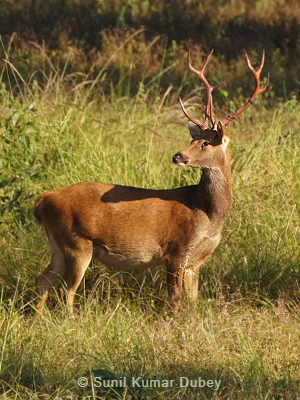
The Barasingh sub-species found in Madhya Pradesh is called hard-ground Barasingha (Rucervus duvaucelii branderi). We may also use the term hard-ground swamp deer for them. As per their name, they are mostly seen at grasslands, river banks and water holes, consuming grass and taking rest on grasslands. Due to their feeding and natural habitat, they are different from the swamp deer species found at Eastern part of India like at Dudhwa tiger reserve, Kaziranga national park etc. The word Barasingha is a hindi language word which simply means a deer with 12 antlers. Here Bara means 12 and singha means antlers. Now question arises that on images, only 2 major antlers are visible so how it is 12 antlers. Answer lies in the branching of antlers. They mostly have 3 level branching so each side have 6 + 6 = 12 antlers in total. They are very sensitive to their habitat thus they were on verge of extinction in 1970 and last population was surviving at Kanha tiger reseve. Then forest department began their historical Barasingha conservation project and Kanha zone of Kanha national park was its epicenter where special enclosure was prepared for them for breeding and population growth. As a result their population again revived and now they are shifted to other forests like Bandhavgarh tiger reserve, Satpura tiger reserve so that population will spread and we will notice overall growth in their population.
At Madhya Pradesh, address of hard-ground Barasingha for tourists is same i.e. Kanha national park. Here we can find them at safari zones like Kanha zone, Mukki zone, Sarhi zone and sometimes are Kisli zone also. At Satpura national park, very soon we will find them in tourism areas. As if they are in non-tourism forest areas (Bori wildlife sanctuary). In coming years, we may find them at Bandhavgarh and Sanjay Dubri tiger reserves also.
| Places for best viewing | ||
| Kanha National Park | Satpura National Park | |
At Kanha national park, we can find them throughout the year as meadow areas of tourism zones. Still from photography point of view, we recommend visitors to visit the national park in period from November to mid of March. Till this period of time, their body coat shows more striking golden yellow color which comes very good in photographs. With the increase in temperature, from April month, we will notice that their body coat color becoming dull or faded thus winter or post monsoon period is good to see them, at Kanha national park.
Please check below given table to learn some vital details and characteristic features.
| Title | Details |
| Kingdom | Animalia |
| Phylum | Chordata |
| Sub-phylum | Vertebrata |
| Class | Mammalia |
| Order | Artiodactyla |
| Sub-order | Ruminatia |
| Family | Cervidae |
| Genus | Rucervus |
| Species | R. duvaucelii |
| Body color | Golden yellow or Rufous |
| Life Span | 20-23 Years |
| Size | Shoulder height is 42-46 inches, Length is 4-6 feet from mouth to tail. |
| Weight | Stag weight ranges 170 to 280 kg, female weighing 120 to 140 kg. |
| Conservation Status | Vulnerable |
| Nature | Mainly diurnal |
| Gestation Period | Approx. 08 months. |
| Breeding Season | November to January months, Rutting calls are indication |
| Relationship | Polygynous |
| Dietary | Herbivores |
| Local Names | Barasingha, Son Mrig |